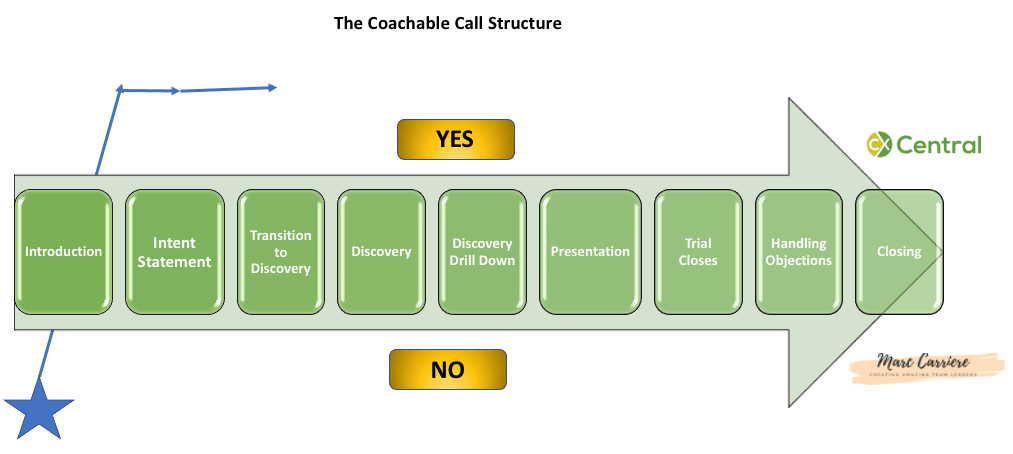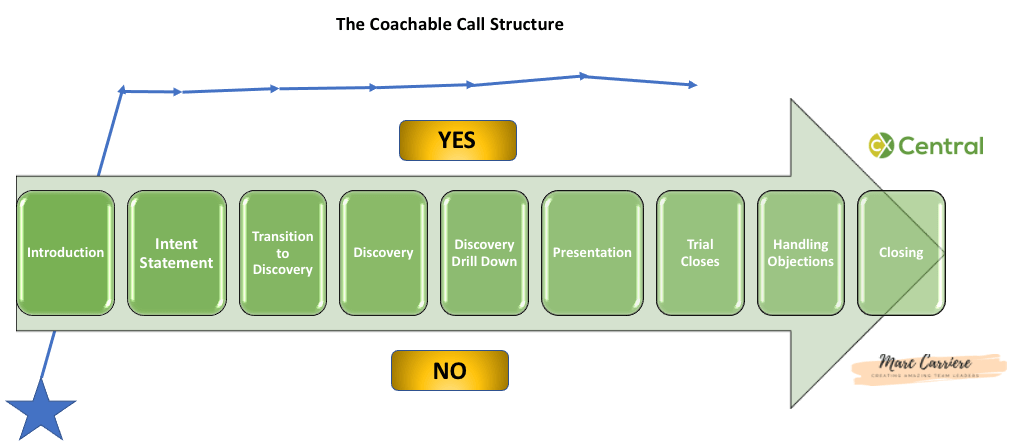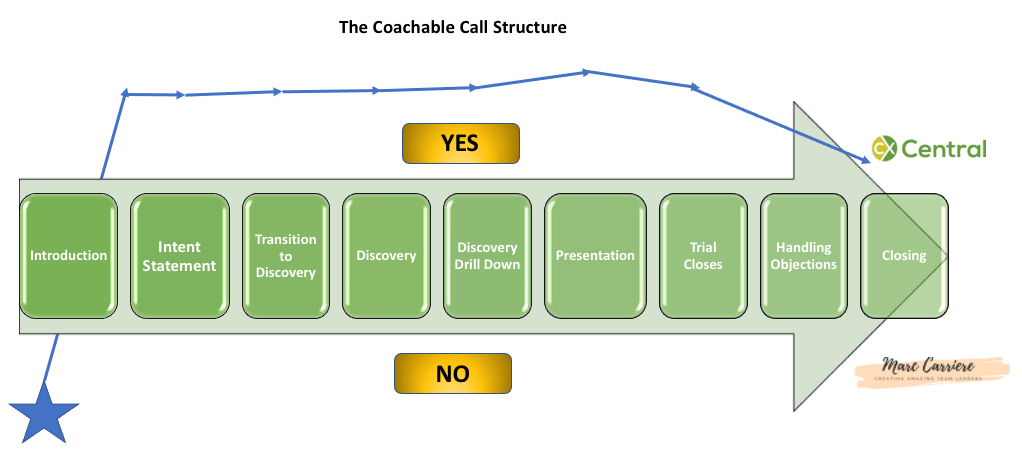
An easy-to-learn Coachable Call Structure
Are too many of your operators, especially new hires, taking way too long to hit their sales targets?
And, are your Team Leaders having trouble training or coaching the best way to conduct inbound or outbound sales calls?
If you’re having these problems, then you need an easy-to-coach call structure process that breaks down each step of a call so your team members have a clear understanding of the proper steps to follow to increase their close rates.
To get you started, here’s a coaching process that I created about 26 years ago that I’ve had a lot of success with training tons of operators, Team Leaders and Call Center Managers all over the world.
In the example below I use a Call Structure designed for a telesales environment, however, the format can easily be modified for customer service, as well.
It’s based on a tool I created called The Calling Line that provides a coachable call structure that can be taught by Team Leaders and easily followed by frontline agents.
Why most agents are failing at sales
Usually when you talk with sales underperformers and ask them where they need the most help, pretty much all of them will tell you they need help in closing the sale.
After you listen to a few of their calls you quickly find they’re losing people at the beginning of the call, usually not long after ‘Hello’, and, most operators are oblivious to it!
You hear them rushing through their calls, jumping all over the place, and not finding out if there is anything about what they’re selling that actually interests the prospect.
Team Members need an easy-to-understand Call Structure they can follow for every call, and I’m not talking about a calling script or call guide.
The Coachable Call Structure
The best way I’ve found to coach The Calling Line is to do an exercise on a whiteboard setting out all the steps in your call structure like this:
When you do, make sure to place a YES above the line and a NO below the line.
Then explain that this call structure represents the sequence or steps of a call over the time the call takes, and what you’re going to do in this exercise is track where the prospect is during the call sequence in relation to whether they will buy or not.
This process helps team members really understand the importance of each step of the call and how completing each step properly within the structure before they move onto the next step will increase their close rate.
As I mentioned earlier, this works whether you’re coaching the best way to handle inbound or outbound sales calls and with a few tweaks, customer service calls too.
The only difference for outbound sales and customer service calls would be some different tweaks for the first few steps of those call types.
To show you how this works in a practical sense, I’ll use an inbound sales call as the example.
Now the thing to point out when teaching this process is to mention that when a prospect is asked to buy during the call, if they are above the Calling Line they will always say YES, guaranteed 100% of the time, no matter what.
Obviously, what we need to do is move them up above The Calling Line if we’re ever going to get them to say ‘YES’, right?
Introduction Phase
So, before you answer any call it’s an important thing to remember that most people only buy from those they trust, and people only trust those they like, and they’ll only come to like you if you’ve developed some rapport with them.
When we think about that, we need to consider what this means with regard to the introduction step of the call.
This is where you discuss the important elements of your introduction things like: thanking them for calling, using their full name and using your name.

But more importantly, start developing rapport by being real.
Just being yourself, speaking with a smile in your voice and being respectful; and what I mean by being real is to drop the fake enthusiasm.
People are so over fake enthusiasm and can feel it right away.
When they do, they move further below The Calling Line on the NO side, and that’s the last thing we want them to do, right?
Just be yourself and present yourself properly to start moving your caller up over The Calling Line by saying something as simple as: Good morning, thank you for calling company name, this is Marc speaking. How can I help you?
Intent Statement & Transition to Discovery Phase
After the caller tells you why they’re calling, move into the Intent Statement and transition to the Discovery phase of the call sequence by saying something along the lines of:
Thanks for your call Mrs Caller, I’d be happy to help you with that and I’ll make sure you get exactly what you want. We have a lot of different options and some special pricing on that, so to make sure I totally understand what you want, may I ask you a few questions?
This helps build more rapport by showing genuine interest in what the caller wants, and gives you permission to ask questions to help you understand what they really want, which also allows you to customise your presentation and specifically speak to what they want the product to do for them.
Handling your Introduction this way shows you’re genuinely interested in helping them get what they want, and helps you build rapport to move them up above The Calling Line.
Discovery & Discovery Drill Down Phase
In the Discovery phase, we start to learn what is important to the caller.
And, by asking the right questions, in the right sequence we’ll get to understand what the caller wants your product or service to do for them.
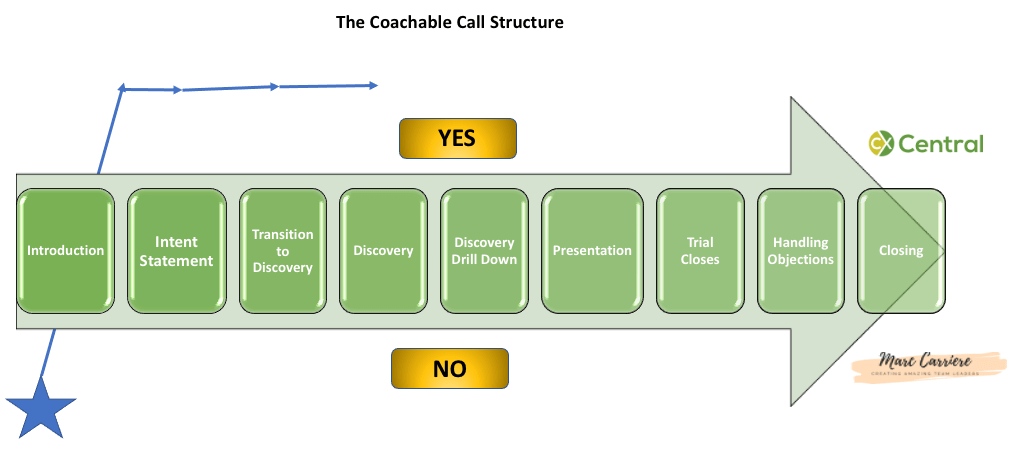
And, by asking relevant questions in a friendly manner that shows genuine interest, callers will feel you’re trying to help them rather than sell them, which makes them more open and comfortable speaking with you.
We also Drill Down on the answers to our Discovery Questions to understand not only what is important to them, but why it’s important to them!

Presentation Phase
This is crucial because when we are in the Presentation phase of the call we can use the consumer intelligence we’ve learned from our Discovery to personalize our Presentation in a way that speaks to the benefits that are important to them, and confirm these benefits with Trial Closes.
Here’s an example of what I mean…
Team Member: So, it needs to be in that particular colour… if you don’t mind me asking, why is that?
Caller: Well, that’s the best colour that goes with my outfit, and it would look absolutely stunning at this work function I need to go to.
Team Member: Oh, I totally get it, and a work function sounds like fun, when is it?
And, of course, you file this intelligence to use later in the Presentation phase of the call.
Now, when you conduct your Discovery and Drill Down this way, your caller will feel you’re genuinely interested in what they want and that you want to make sure they get exactly what they want.
And, because they feel this way they will move up higher above The Calling Line.
Always remember: People want to know how much you care before they care about how much you know.
Now, all we have to do is show them how what we’re selling will give them what they want!
To do this, keep your Presentation focused on their needs and wants – not your needs and wants.
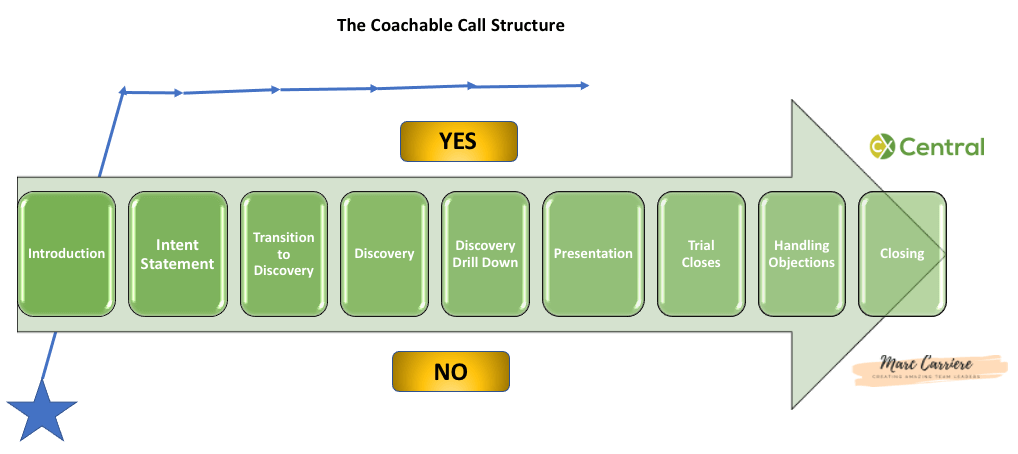
You do this whenever you mention a Feature that addresses what they want by describing the BENEFIT they receive from this FEATURE.
Just remember to stay away from presenting features that the prospect has no interest in.
Trial Closes & Handling Objections Phase
If they’re not interested in a feature, why give them an excuse to use that as their “I’m not interested” objection?
When you do a really good Discovery and Drill Down you can deliver a great presentation that focuses on exactly what they want the product or service to do for them.
And, with a great Presentation that speaks to exactly what a caller wants you don’t get a lot of objections.
If you do, typically those objections usually revolve around certain conditions, not objections, which can likely be handled with some negotiation.
After you’ve presented the feature and the benefits that are important to them, tie that all down with your caller to easily transition into the closing part of the call with trial closes like: Well, we do have that in royal blue. That’s the colour you wanted to make your outfit stunning, isn’t it?
And, once they get a YES, simply move into the Close sequence by saying: We have that in stock for $X right now, and can have it delivered to you by X date. So, you’ll have it in plenty of time for your function. Does that work for you?
If so, they continue with: Great, which credit card would you like to use?
Closing Phase
Closing a sale is just the natural conclusion of a good presentation.
Provided you’ve established good rapport through your Introduction and Discovery phases, you should have established a certain level of trust.
And, provided you’ve presented the features and benefits of what you’re selling in such a way that pushes their Hot Buttons, why wouldn’t they want to buy?
Now, if you’ve followed all the steps effectively, then aside from the cost, they’ll say yes, wouldn’t they?
And, if it just comes down to the money, you’re so very close to a sale!
Another important thing to remember when you’re in the closing part of the call is after you ask the caller to buy; they will automatically drop down closer to The Calling Line.
But, if they are still above The Calling Line they will always say yes… 100% of the time, guaranteed.
With this in mind, you need to be sure that you’ve driven them up over The Calling Line as high as you can during the Discovery and Presentation phases of the call, so when you ask them to buy… and they drop down, they’re still above The Calling Line.
Summary
The problem most underperformers have is that they just go from the Introduction part of the call straight to Presentation and miss out on the most important steps in between.
And because they haven’t had an opportunity to build enough rapport or get a really clear understanding of what the caller wants, they can’t present the product or service in a way that really speaks to what the caller wants.
Missing out on these steps is the biggest reason why most sales are lost and why team members think they need help with their closing skills.
The truth is it’s got nothing to do with improving their closing skills or learning how to handle objections better, because without these earlier critical steps they aren’t properly prepared and haven’t earned the right to ask for the sale.
This is a good time to discuss one of the biggest problems underperformers create for themselves by just barrelling through their call without paying attention to how prospects are responding, and running into objections like ‘I’m not interested’ and losing a sales opportunity.
To really help them understand the importance of following the call sequence properly, and not moving from one part of the call to the next until the prospect is ready is by taking them through a simple exercise by asking them how they know when to stop and go when driving their car when coming to lights at an intersection.
Naturally, they’ll tell you that they know when to stop because the light turns red, and when the light turns green they can continue.
Then ask them, what happens if they ignore the red light and just keep driving through the intersection?
Of course, they’re going to say that you’ll probably have a crash.
Then you tell them one of the main reasons they aren’t closing better is that they’re probably missing stop signals from their prospects and just barrelling through their call and crashing.
So, they need to really listen to their prospect during each step of the call and only move onto the next step if they have a green light.
This will make them very aware of how they’ve been conducting their calls and open up a discussion on the usual stop signs they come up against in each area of their call.
And, you’ll be able to coach them on how they can get the signal to turn from red to green, so they can move forward.
I promise if you incorporate this exercise into your training session on The Calling Line with your team it will really help them see the stop signals coming up in their calls and learn how to turn these stop signals green before they move forward.
Recommended Links:
- Purchase: You can download the full guide/tutorial here >
- Learn: Save $1,000 on Marc’s Creating Amazing Team Leaders online course. Use the coupon code OCC4243
- Read: How to write an effective call centre script
- Training: View all our courses specifically designed for call centres including Team Leaders, agents, managers, quality assurance and more
- Upskill: View all the upcoming industry conferences, webinars, training courses and more.



